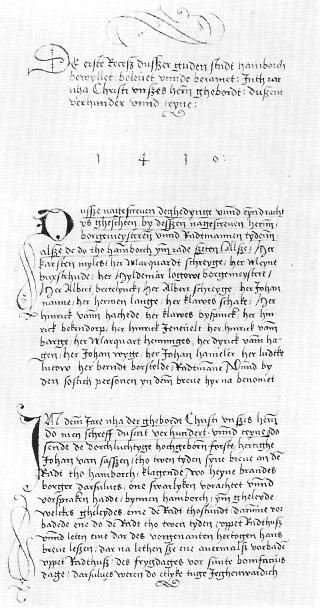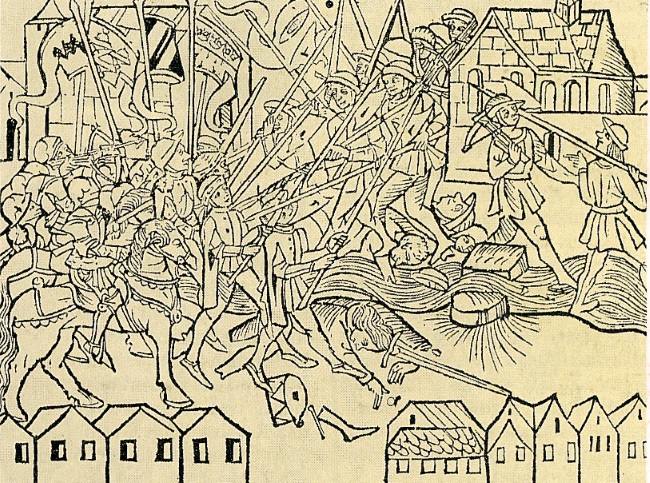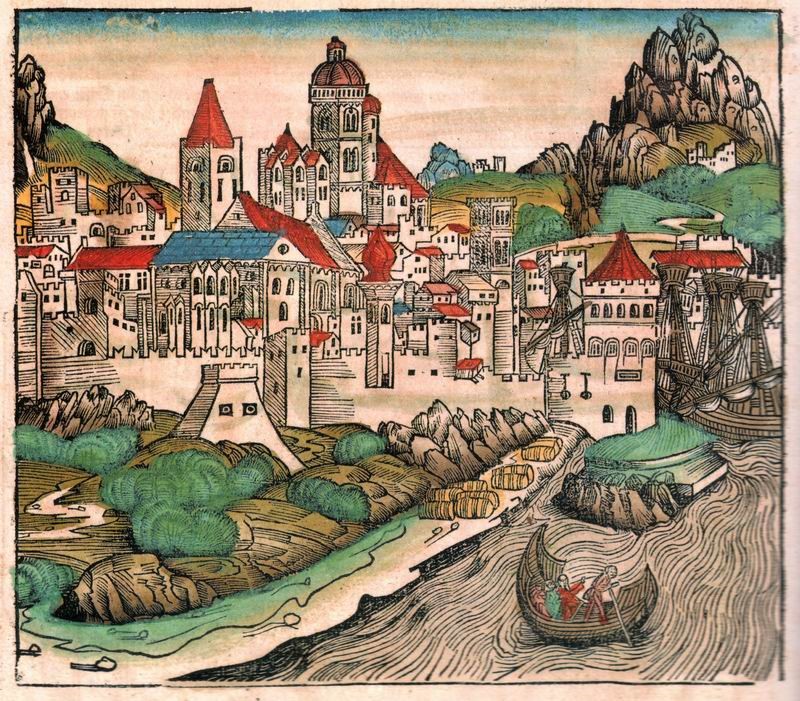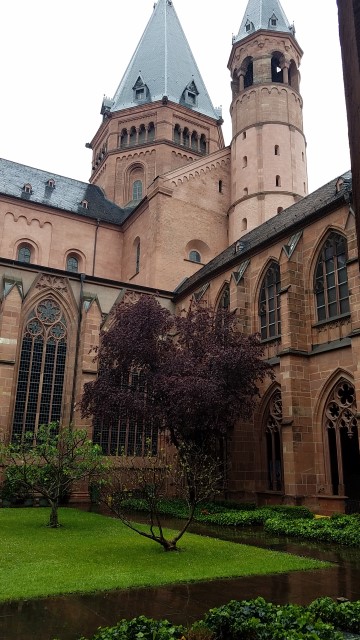Most of the great advances of the Renaissance were at the end of a long chain of ideas originating in the Classical World of ancient Greece and Rome. But there were also some key innovations which seem to be derivations of another, far less well understood context – the indigenous or “barbarian” cultures of the people already living in Europe before Rome began to expand. Those peoples did not leave us a lot of records so it’s much harder to trace the origins of their ideas, which we know mainly from echoes left in epic poems, commentary by Romans and Greeks, and survivals in later periods. But many of the strongest currents in medieval society originated in the murky past of tribal cultures we don’t know that much about. A few of these cultural artifacts remain relatively unknown today even though they were quite Important in the medieval period.
The great city-states of the Classical world are world famous for their astonishing achievements in art and Natural Philosophy covering a wide range of fields, from astronomy to mathematics, medicine to law. The genius of the Classical auctores[1] is not to be underestimated. Not only were they enormously influential upon medieval culture, (many aspects of medieval law for example were directly adapted from Greek and Roman sources), their ideas, systems, and terminology are still the basis of medicine, law, mathematics and chemistry today.
But along with all the erudition, there were major flaws in the cultural software of the Polis and the Civitas, and those too left a legacy. Their reliance on slavery, and the subordinate role of women in most Classical societies are two major problems. Another, perhaps their most fatal flaw of all, was a tendency for competition both between and within city states to escalate into destructive violence. This ultimately led to disaster and ruin, to the unraveling of many magnificent and unique societies and to their decline and subjugation by rivals or foreign powers. It is what brought the magnificent Golden Ages of Greece to an end, and ultimately contributed to the decline and fall of Rome as well. In other words, over the long run, inter- and intra- community rivalry was a high stakes game with highly negative outcomes for almost all involved. And in many parts of Europe, for a variety of reasons, this pattern returned in the medieval era.
Not long after successfully uniting to throw off the yoke of the Holy Roman Emperor in the 12th Century, the cities in Tuscany and Lombardy became bitter rivals, and within these cities, vendettas between political factions such as the Guelph’s and Ghibellines often tore apart the social fabric. This internal strife contributed to weakness which time after time doomed the community to conquest by other cities, foreign kingdoms, the Pope, or even by condottieri[2] who they had hired to protect them. In Northern Italy, this meant that the number of free urban republics, of whom sixteen were signatories to the Lombard League in 1171, had been reduced to a handful by the dawn of the 15th Century. By 16th, only Venice retained her independence. The Italian Renaissance, first and greatest of them all, was being smothered under a weight of German, French and Spanish swords.
North of the Alps (and East of the Rhine) events took a different path. There too, the towns had dangerous internal and external rivalries. Conflicts broke out between Central European towns just as they did in Italian towns, and there were countless political disturbances within the cities as well. According to one estimate, there were at least 210 uprisings in just 40 towns in the Holy Roman Empire between the late 13th and mid-14th Centuries[3]. In Central Europe, as in Italy, there were cases where towns destroyed themselves through internal divisions, losing their autonomy in the process. There were also cases where towns went to war with each other and the strong preyed upon the weak, the large upon the small.
But more often than not, when there was a major political disturbance, in aggregate, the outcomes followed a different pattern than was typical among the Lombards. Rather than continue to fight until one side was annihilated and the other mortally weakened, many of the northern towns employed something called the Rezeß. This is an almost untranslatable and now archaic German term which very roughly means ‘backing down’ or ‘backing away’, or ‘retiring’. In practice it meant two things: First, the parties involved in a conflict recognized that no further gain could be made by continued violence or confrontation and stopped fighting; Second, this recognition would typically result in a written legal agreement which would thenceforth be binding for all parties. These Rezeß agreements were hashed out in surprisingly good faith, on the basis of the true power relations between the various factions involved in the dispute, and could result in political agreements which lasted for centuries. In some cases, the Rezeß became part of the town charter or even the basis of a new constitution, as was the case in Hamburg in 1410.

The Hamburg Constitution from 1410. Public Domain.

The violent denouement of a weaver’s revolt in Cologne in 1371, from the Koelhoffschen Chronik. Public Domain.
In that northern Hanseatic city, in the year 1408 there was an incident fairly typical for the time, in which a noble, in this case the duke of Saxe-Lauenburg, got into a dispute with an artisan who he considered his inferior. The duke owed money to an armorer named Hein Brandt (or Heyne Brandes in the local Low German dialect). When the armorer, who had not be paid for an expensive harness[4] demanded his money in somewhat forceful language, the duke, who was in the town under a safe conduct, complained to the Hamburg senat[5], who had the armorer arrested[6]. This incident quickly triggered a public disturbance as other artisans rallied to the cause of their fellow citizen and demanded the release of Brandt and punishment of the noble. The senat, made up wealthy merchants, preferred a policy of appeasement to avoid war with the duke, who was a powerful regional prince.
This in turn triggered a political crisis which lasted two years, as the working class artisans harbored long-standing grievances with both the rural nobility and with the oligarchic senators who ruled the city. They mustered in significant numbers, took up arms, and formed a committee of 48 aldermen or deacons, 12 from each of the four town parishes. The city council still had the support of most of the patrician families, and for two years Hamburg teetered on the brink of civil war. Very similar incidents sometimes resulted in tragic outcomes.
As one example, in Krakow in 1461 an armorer was badly beaten by an important nobleman named Andrzej Tęczyński over the issue of an ill-fitting harness. Tęczyński was at the time one of the leaders of the Polish army in their war against the Teutonic Knights. In the event, moderation was ignored by both sides and Tęczyński was killed by a mob, and the city of Krakow ended up having to surrender nine of its own citizens to the king to be executed[7].There was, in other words, no Rezeß at the time of that incident, at least not until it was already over. Nor was this the worst possible result. In Mainz in 1461 internal strife led to a violent takeover by Bishop Adolph of Nassau. Mainz lost her status as a Free City permanently.

Mainz in 1496, from the Nuremberg Chronicle. Johannes Gutenberg left the city after political violence in 1450. Public Domain.

The Cathedral garden in Mainz in 2019, photo by author.
Fortunately for the citizens of Hamburg, in 1410 a settlement turned out to be possible. Recognizing that a civil war would threaten the autonomy of the city and cost many lives, the two factions met and over a period of four days, arranged a compromise which came to be known as the Erster Rezeß or first Rezess. The armorer Brandt was released, and a new twenty-point agreement was hashed out, forming what is now considered the first constitution of the city of Hamburg. The forty-eight representatives of the artisans and lesser merchants, known as the die Achtundvierziger (Forty-Eighters), continued to persist and in effect became the lower house of Hamburg’s ruling council, beneath the senat.
In addition, the citizens acquired a number of significant rights. Hamburg was one of the most powerful Free Cities of the Hanseatic League, and as such, they conducted their own foreign policy, which sometimes meant going to war, without much consideration for the wishes of the Emperor or any other prince. But from the time of the 1410 agreement, decisions on war or foreign alliances would have to consider the wishes of the town citizens. According to Article 6 of the new constitution, any declaration of war or new alliance had to be approved by a plenary assembly of the entire citizenry. In addition, no full or partial citizen cold be arrested without a hearing, unless caught red handed in a major crime. Article 10 stated that the senat could no longer grant safe passage to nobles or anyone else who owed money to a citizen. Article 15 required any public servant who acted against the wishes of the citizenry to be fired.
Did this turn Hamburg into an egalitarian utopia? Certainly not. But it expanded the enfranchisement of the people who lived there from a few dozen alloidal land owners and elite merchants to nearly half of the population (those who had at least half citizenship). Considering that in the United States at the time of this writing, the President can now start wars without even a vote from the legislature, the amount of democratic oversight by the Hamburg citizens is remarkable. Nor was it unique in its context.
Throughout Central Europe, in dozens of cities, uprisings by the lower ranks of citizenry resulted in similar hybrid republics. Sometimes they were put down by the wealthy urban patriciate, as in Nuremberg in the late 14th Century. Sometimes the craft guilds took over as in the weavers uprising in Cologne in 1396. More often it was a hybrid between two types. Cologne was one of the more radical governments, where like Hamburg, they created a new city constitution (verbundbrief) which stipulated not only enfranchisement of all citizens, but also equal wages for male and female artisans[8], and a popular vote on any tax increase. Such reforms would seem astonishing in the 19th or early 20th Century England or the United States, though they were fairly common in towns in what are now Germany, Poland, Flanders and Czechia in the 15th Century.
Reforms didn’t necessarily last long in the Free Cities of the Holy Roman Empire and neighboring regions where they took place. As in most republics, freedoms won were gradually eroded by the new regimes and the old guard alike. But then new reforms happened, and a new cycle started, often enough and with sufficiently muted violence, that the urban republics of Central Europe did not simply harden into oligarchies, nor did they tear themselves apart with internecine conflicts. This in turn kept them alive and viable, often for a very long time.
Depending on how you measure it, the Athenian republic and nominal democracy lasted in some form roughly from 462 – 322 BC, interrupted by short periods of oligarchy or dictatorship. This ~140-year period coincided with a philosophical Golden Age, and generated a profound and powerful cultural legacy which continued to be felt through the Hellenistic period, through the rise and fall of the Roman Empire, and ultimately had great influence on European and Middle Eastern societies for Centuries to come. It continues to have great influence today.
Hamburg was a republic in some form for quite a while. You could place this at the formation of their city council or senat in 1227, or at the time of the first Rezeßand somewhat democratic constitution in 1410, and end it either in 1762, when a Danish army occupied the city, or in 1810 when Napoleon invaded, or (because it re-formed itself after Napoleon was defeated) still later when the German Empire was born in 1876. Depending on how you measure it therefore it was a republic either for 352 years or 583 years. Either way, an impressive run for a Republic. And Hamburg is not an outlier for the Free Cities north of the Alps.
Though certainly a great city in its own right, Hamburg alone was not the equal of Athens in terms of cultural, philosophical or artistic influence. The Golden Age of Athens shone brighter than almost any in the world, and still shines today. But towns like Hamburg, Lübeck, Strasbourg, Cologne, Bruges, Ghent, Augsburg, Nuremberg, Frankfurt, Prague, Basel, Zurich, Gdansk, Krakow (all of which remained autonomous for centuries) and the roughly 300 other Free Cities which achieved autonomy for some period within the Middle Ages in Central Europe, also left their mark on European and world culture, one which isn’t always as well appreciated or understood, but whose effects are nevertheless also felt today. In Hamburg alone we found the composers Johannes Brahms and Felix Mendelssohn, the physicists Jame Franck and Gustav Hertz, just to name a few. Of course, the Late Medieval period the self-managed urban polities of Central Europe were the incubator for the Northern Renaissance. Many of the great names of the period: Albrecht Dürer, Hans Memling, Hans Holbein, Erasmus, Paracelsus, Johannes Gutenberg, Robert Campin, Nicolaus Copernicuset al, either originated or rose to prominence within the special urban spaces – in a culture nurtured in tiny republics.
What does the rezess mean … what is so special about it? The rezess, and its equivalent traditions of what we might call the enhanced art of compromise, helped shape European history. Many of the greatest entities to emerge in Late Medieval Europe: The Hanseatic League, the Swiss Confederation, the great alliance of Poland and Lithuania, the alliance of the Kingdom of Poland with the mostly German cities of Prussia, the (eventual) ability of Bohemia to make peace with her neighbors in spite of being heretics, and the Holy Roman Empire itself, all existed thanks in no small part to this phenomenon.
On the face of it, it’s a very simple idea. You compete, you fight until it’s clear that more fighting is going to become counterproductive, and then you cut a deal. But it’s a tricky balancing act. No doubt, Game Theory would predict a high likelihood of failure. Certainly, in our cultural DNA, we have forgotten it. Plato described five regimes of human society, in which tyranny inevitably follows democracy. This was perhaps a self-fulfilling prophecy, and one which was played out repeatedly in the City States and Empires of the Classical World. Today, Plato still casts a long shadow, and seem to assume that what he predicted is indeed inevitable. But if we look at cities like Hamburg or something larger like the Swiss Confederation, we can see that a substantial degree of self-management can last far longer than Athenian Democracy did. Centuries longer. Even when all around them, Europe had become the home of the Absolute Monarch, the Swiss retained their liberty. As did many of the Free Cities.
There is no doubt that Greek City-States, Roman Senators and the Renaissance Italian republics had many techniques for compromise and collaboration. Without them, they would have never achieved greatness to begin with. But the ability to reach political compromise in good faith was something that eroded in many societies, and seems unavailable to us in the modern world. Certainly in the 20th Century we saw many examples of the utter failure of political compromise, and very powerful, ghastly reminders of what that can lead to. Renaissance towns suffered from a significant degree of instability – they were not utopias and did not achieve perfect democracy. But they achieved a degree of it in many different forms, and the history of the hundreds of small republics, and the handful of larger ones, which they have left to us have great potential to be mined for their cultural software. At the very least, they serve as a reminder that politics does not always have to be a zero sum game. And that is something we may need to keep in mind, because the Rezeß could be a tool we really need in the near future.
[1] Literally ‘authors’, recognized scholars and great philosophers, such as Aristotle, Ptolemy, Pythagoras, Hippocrates, Galen, Euclid, Vitruvius, Plato, Plotonius, Archimedes, Heron of Alexandria, Virgil, Seneca, Cato and so on.
[2] Military contractors.
[3] “Imperial and Free Towns of the Holy Roman Empire, City-States in Pre-Modern Germany?”, Peter Johanek, p 12 / 306 (from “A comparative study of thirty city-state cultures: an investigation, Copenhagen Kongelige Danske Videnskabernes Selskab 2000)
[4] Suit of armor
[5] The town council of Hamburg was called the senat (‘senate’) and the councilors were called senators.
[6] Tim Albrecht and Stephan Michaelsen, Entwicklung des Hamburger Stadtrechts Archived 2013-12-21 at the Wayback Machine, note 36, retrieved on 14 May 2013.
[7] Janusz Szwaja, Stanisław Waltoś: Pitaval of Krakow . Warsaw: Legal Publishing House, 1962, p. 25.
[8] Women, Production, and Patriarchy in Late Medieval Cities, Martha C. Howell, University of Chicago Press, 1986, page 223
